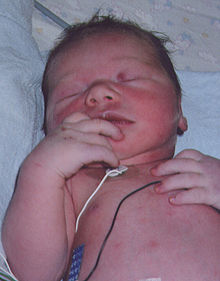- Cyanosis
-
Cyanosis
A baby with a heart condition. Note purple nailbeds.ICD-10 R23.0 ICD-9 782.5 eMedicine med/3002 Cyanosis is the appearance of a blue or purple coloration of the skin or mucous membranes due to the tissues near the skin surface being low on oxygen. The onset of cyanosis is 2.5 g/dL of deoxyhemoglobin.[1] The bluish color is more readily apparent in those with high hemoglobin counts than it is with those with anemia. Also the bluer color is more difficult to detect on deeply pigmented skin. When signs of cyanosis first appear, such as on the lips or fingers, intervention should be made within 3–5 minutes because a severe hypoxia or severe circulatory failure has induced the cyanosis.
The name cyanosis, literally means "the blue disease" or "the blue condition". It is derived from the color cyan, which comes from kyanos, the Greek word for blue.[2]
Human blood is always a shade of red,[3] and the more oxygenated the blood the brighter the shade of red. The more deoxygenated the blood, the darker red it is within the blood vessels, and the more bluish it appears on the skin. This color shift occurs because the optical properties of skin shift the darker red colors towards the bluer.[4] (Some colors are refracted and absorbed more than others.) A similar phenomenon makes the sky appear blue.
Contents
Definition
Cyanosis is defined as a bluish discoloration, especially of the skin and mucous membranes due to excessive concentration of deoxyhemoglobin in the blood.
Differential diagnosis
Cyanosis is divided in to two main types: central (around the core and lips) and peripheral (only the extremities are affected). Cyanosis can occur in the fingers, including underneath the fingernails, as well as other extremities (called peripheral cyanosis), or in the lips and tongue (central cyanosis).
Central cyanosis
Central cyanosis is often due to a circulatory or ventilatory problem that leads to poor blood oxygenation in the lungs. It develops when arterial saturation of blood with oxygen is ≤85%. Cyanosis may not be detected until saturation is 75% in dark-skinned individuals.
Acute cyanosis can be a result of asphyxiation or choking, and is one of the surest signs that respiration is being blocked.
Causes
1. Central Nervous System:
- Intracranial hemorrhage
- Cerebral anoxia
- Drug overdose (e.g. Heroin)
2. Respiratory System:
- Bronchiolitis
- Bronchospasm (e.g. Asthma)
- Lung disease
- Pulmonary Hypertension
- Pulmonary embolism
- Hypoventilation
- COPD (emphysema and chronic bronchitis)
- Respiratory syncytial virus
3. Cardiac Disorders:
- Congenital heart disease (e.g. Tetralogy of Fallot, Right to left shunts in heart or great vessels)
- Heart failure
- Heart valve disease
- Myocardial infarction
4. Blood:
- Methemoglobinemia
- Polycythaemia
5. Others:
- High altitude
- Hypothermia
- Congenital cyanosis (HbM Boston) arises from a mutation in the α-codon which results in a change of primary sequence, H → Y. Tyrosine stabilises the Fe(III) form (oxyhaemoglobin) creating a permanent T-state of Hb.
- Obstructive sleep apnea
Peripheral cyanosis
Peripheral cyanosis is the blue tint in fingers or extremities, due to inadequate circulation. The blood reaching the extremities is not oxygen rich and when viewed through the skin a combination of factors can lead to the appearance of a blue color. All factors contributing to central cyanosis can also cause peripheral symptoms to appear, however peripheral cyanosis can be observed without there being heart or lung failures. Small blood vessels may be restricted and can be treated by increasing the normal oxygenation level of the blood.
Causes
- All common causes of central cyanosis
- Arterial obstruction
- Cold exposure (due to vasoconstriction)
- Raynaud's phenomenon (vasoconstriction)
- Reduced cardiac output (e.g. heart failure, hypovolaemia)
- Vasoconstriction
- Venous obstruction (e.g. deep vein thrombosis)
Differential cyanosis
Differential cyanosis is the bluish coloration of the lower but not the upper extremity and the head. This is seen in patients with a patent ductus arteriosus. Patients with a large ductus develop progressive pulmonary vascular disease, and pressure overload of the right ventricle occurs. As soon as pulmonary pressure exceeds aortic pressure, shunt reversal (right-to-left shunt) occurs. The upper extremity remains pink because the brachiocephalic trunk, left common cartoid trunk and the left subclavian trunk is given off proximal to the PDA.
See also
References
- ^ Mini Oxford Handbook of Clinical Medicine (7th ed.). p. 56.
- ^ Mosby’s Medical, Nursing and Allied Health Dictionary. Mosby-Year Book (4th ed.). 1994. p. 425.
- ^ Except in rare cases of hemoglobin-related disease.
- ^ Kienle, Alwin; Lothar Lilge, I. Alex Vitkin, Michael S. Patterson, Brian C. Wilson, Raimund Hibst, and Rudolf Steiner (March 1, 1996). "Why do veins appear blue? A new look at an old question" (PDF). Applied Optics 35 (7): 1151–60. doi:10.1364/AO.35.001151. PMID 21085227. http://www.imt.liu.se/edu/courses/TBMT36/pdf/blue.pdf.
External links
Symptoms and signs: skin and subcutaneous tissue (R20–R23, 782) Disturbances of skin sensation/
somatosensory disorderCirculation Edema Other Categories:- Medical signs
- Symptoms and signs: Skin and subcutaneous tissue
Wikimedia Foundation. 2010.


